新人教版六年级英语知识点总结.doc
完整版)人教版六年级英语上册知识点汇总总结提纲
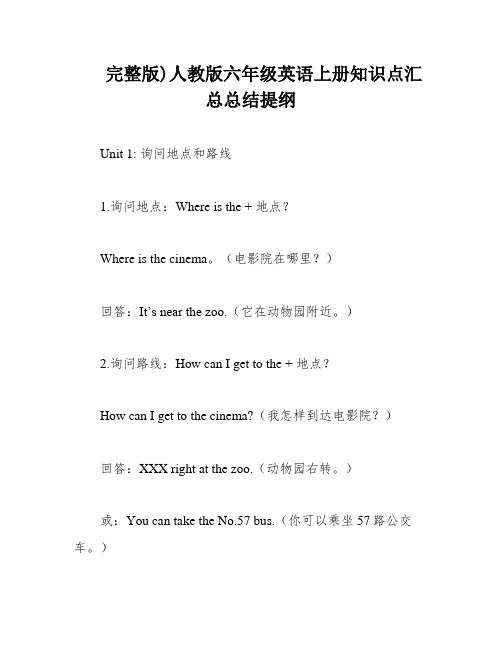
完整版)人教版六年级英语上册知识点汇总总结提纲Unit 1: 询问地点和路线1.询问地点:Where is the + 地点?Where is the cinema。
(电影院在哪里?)回答:It’s near the zoo.(它在动物园附近。
)2.询问路线:How can I get to the + 地点?How can I get to the cinema?(我怎样到达电影院?)回答:XXX right at the zoo.(动物园右转。
)或:You can take the No.57 bus.(你可以乘坐57路公交车。
)Unit 2: 交通方式1.询问某人怎样去某地:How do某人go(come) to + 地点?How do you go to school?(你怎么去学校?)回答:I go to school on foot.(我走路去学校。
)2.规定某人必须做某事:某人 + must + 动词原形XXX.(骑自行车的人必须戴头盔。
)I must pay n to the traffic XXX.(我必须注意交通信号灯。
)Unit 3: 打算做某事某人 + be going to + do(动词原形)She is going to see a film.(她打算去看电影。
)My uncle is planningXXX to go to the supermarket。
In this unit。
there are several types of ns that we can use to XXX。
For example。
we can ask "What are you going to do (+time or place)?" or "When are you going (+place)?" to get an XXX may include phrases such as "I am going to the cinema tomorrow" or "They are going to Nanjing next week."Similarly。
最新人教版小学六年级英语小学知识要点归纳汇总(全年级)

最新人教版小学六年级英语小学知识要点
归纳汇总(全年级)
根据您的要求,以下是标题为“最新人教版小学六年级英语小学知识要点归纳汇总(全年级)”的文档,共800字以上。
语法要点
- 时态:一般现在时、一般过去时、将来时、现在进行时、过去进行时
- 动词的用法:及物动词和不及物动词
- 形容词和副词的比较级和最高级
- 名词的单数和复数形式
词汇要点
- 常用的动词、名词、形容词和副词
- 数字和时间的表达方式
- 问路时常用的词汇和句子
- 四季和天气的词汇
- 学校生活和研究用语
句型要点
- 陈述句、疑问句、祈使句和感叹句的构成和用法- 简单句和复合句的区别和构成
- 常用的连词和过渡词
阅读要点
- 短文理解:根据短文回答问题、判断正误等
- 短文写作:写一篇关于某个话题的短文
口语表达要点
- 自我介绍和询问他人情况的常用表达方式
- 日常生活中的问候和交流用语
- 表达个人喜好和兴趣的句子和词汇
以上是关于最新人教版小学六年级英语小学知识要点的简要归纳汇总(全年级),希望能帮助到您。
如果有其他需要,请随时告知。
人教版六年级上册英语知识点汇总
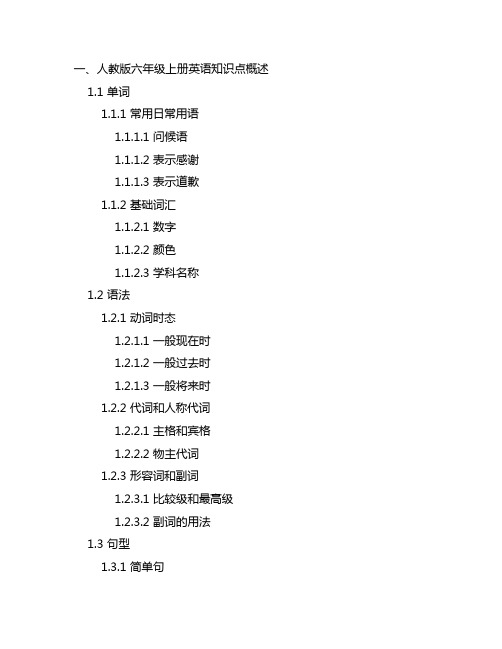
一、人教版六年级上册英语知识点概述1.1 单词1.1.1 常用日常用语1.1.1.1 问候语1.1.1.2 表示感谢1.1.1.3 表示道歉1.1.2 基础词汇1.1.2.1 数字1.1.2.2 颜色1.1.2.3 学科名称1.2 语法1.2.1 动词时态1.2.1.1 一般现在时1.2.1.2 一般过去时1.2.1.3 一般将来时1.2.2 代词和人称代词1.2.2.1 主格和宾格1.2.2.2 物主代词1.2.3 形容词和副词1.2.3.1 比较级和最高级1.2.3.2 副词的用法1.3 句型1.3.1 简单句1.3.1.1 肯定句1.3.1.2 否定句1.3.1.3 疑问句1.3.2 复合句1.3.2.1 并列句1.3.2.2 定语从句1.3.2.3 状语从句二、人教版六年级上册英语知识点详解2.1 单词2.1.1 常用日常用语2.1.1.1 问候语问候语是指在英语日常交际中用于打招呼和示好的常用词汇,包括Hello、Hi、Good morning、Good afternoon等等。
2.1.1.2 表示感谢表示感谢的常用词汇有Thank you、Thanks a lot、Thank you very much等,用于表达对别人的帮助或礼物表示感激之情。
2.1.1.3 表示道歉表示道歉的词汇包括I'm sorry、Excuse me、Pardon等,在日常生活中,用于向别人道歉或请求对方让步的场合。
2.1.2 基础词汇2.1.2.1 数字数字是英语基础词汇的重要部分,包括基本的数字表达方式和计量单位,如one、two、three等,以及hundred、thousand等。
2.1.2.2 颜色颜色是描述事物外观的重要词汇,在日常交流中也经常用到,包括red、blue、yellow等常见颜色词汇。
2.1.2.3 学科名称学科名称涉及到人们日常生活和学习工作的方方面面,包括mathematics、music、art等,是学习英语时必须掌握的词汇。
人教版新版小学六年级英语上册全册学习资料
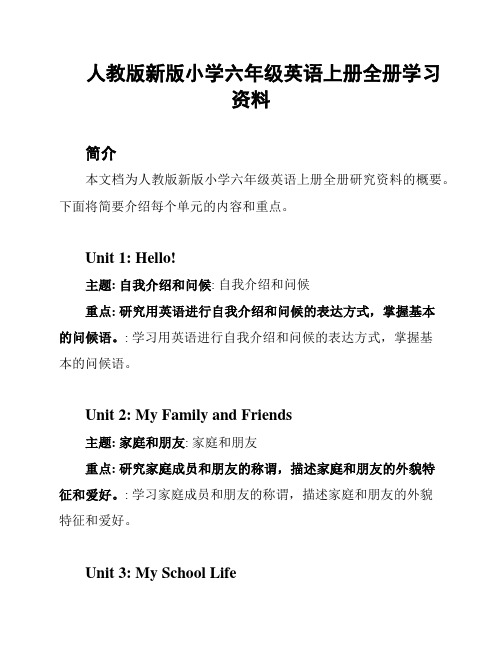
人教版新版小学六年级英语上册全册学习资料简介本文档为人教版新版小学六年级英语上册全册研究资料的概要。
下面将简要介绍每个单元的内容和重点。
Unit 1: Hello!主题: 自我介绍和问候: 自我介绍和问候重点: 研究用英语进行自我介绍和问候的表达方式,掌握基本的问候语。
: 学习用英语进行自我介绍和问候的表达方式,掌握基本的问候语。
Unit 2: My Family and Friends主题: 家庭和朋友: 家庭和朋友重点: 研究家庭成员和朋友的称谓,描述家庭和朋友的外貌特征和爱好。
: 学习家庭成员和朋友的称谓,描述家庭和朋友的外貌特征和爱好。
Unit 3: My School Life主题: 我的校园生活: 我的校园生活重点: 研究描述学校、教室、课程和活动的词汇,了解在校生活中的常见场景。
: 学习描述学校、教室、课程和活动的词汇,了解在校生活中的常见场景。
Unit 4: Leisure Time主题: 休闲时间: 休闲时间重点: 研究谈论休闲活动和爱好,了解并运用动词的ing形式。
: 学习谈论休闲活动和爱好,了解并运用动词的ing形式。
Unit 5: Let's Celebrate!主题: 节日庆祝: 节日庆祝重点: 研究讨论各种节日和庆祝活动,掌握相应的表达方式和词汇。
: 学习讨论各种节日和庆祝活动,掌握相应的表达方式和词汇。
Unit 6: Nature and Environment主题: 自然和环境: 自然和环境重点: 研究描述动物、植物和环境的词汇,了解一些自然保护的知识。
: 学习描述动物、植物和环境的词汇,了解一些自然保护的知识。
总结本册教材包含了六个单元的研究内容,涵盖了日常生活中常见的话题。
通过研究这些内容,学生将能够掌握基本的英语交流能力,并丰富自己的词汇量。
希望本册教材能对学生的英语研究有所帮助。
以上是《人教版新版小学六年级英语上册全册学习资料》的简要介绍。
如需详细内容,请参阅教材。
最新人教版六年级英语下册各单元知识点总结归纳
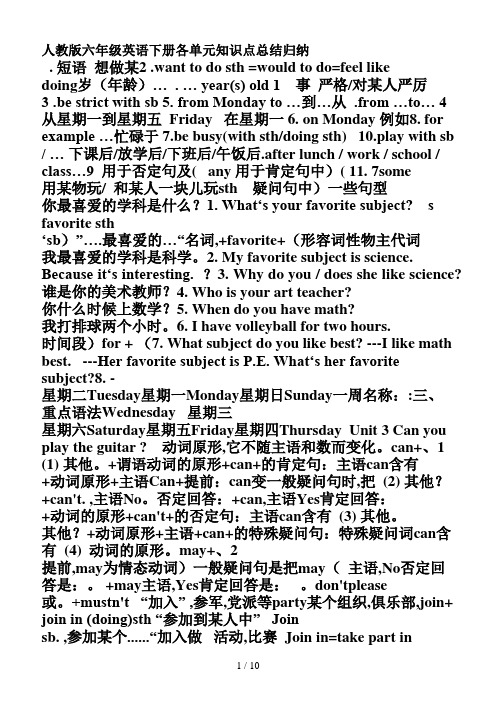
人教版六年级英语下册各单元知识点总结归纳. 短语想做某2 .want to do sth =would to do=feel likedoing岁(年龄)… . … year(s) old 1 事严格/对某人严厉3 .be strict with sb 5. from Monday to ...到...从 .from ...to (4)从星期一到星期五 Friday 在星期一 6. on Monday 例如8. for example …忙碌于 7.be busy(with sth/doing sth) 10.play with sb / … 下课后/放学后/下班后/午饭后.after lunch / work / school / class…9 用于否定句及( any 用于肯定句中)( 11. 7some用某物玩/ 和某人一块儿玩sth 疑问句中)一些句型你最喜爱的学科是什么?1. What‘s your favorite subject? s favorite sth‘sb)”….最喜爱的…“名词,+favorite+(形容词性物主代词我最喜爱的学科是科学。
2. My favorite subject is science. Because it‘s interesting. ?3. Why do you / does she like science? 谁是你的美术教师?4. Who is your art teacher?你什么时候上数学?5. When do you have math?我打排球两个小时。
6. I have volleyball for two hours.时间段)for + (7. What subject do you like best? ---I like math best. ---Her favorite subject is P.E. What‘s her favorite subject?8. -星期二Tuesday星期一Monday星期日Sunday一周名称::三、重点语法Wednesday 星期三星期六Saturday星期五Friday星期四Thursday Unit 3 Can you play the guitar ? 动词原形,它不随主语和数而变化。
人教版英语六年级知识点
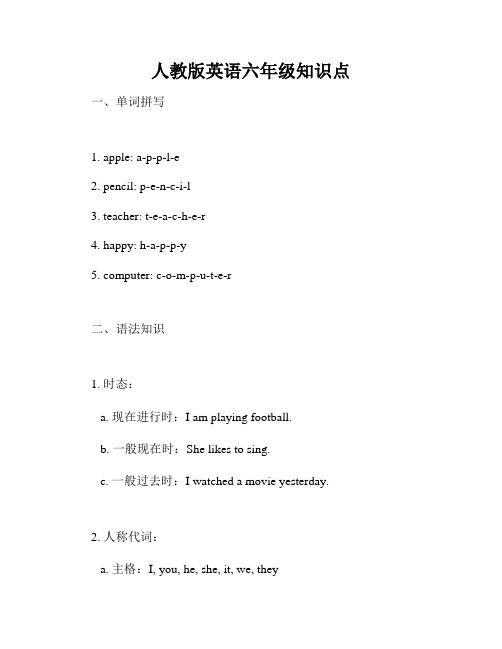
人教版英语六年级知识点一、单词拼写1. apple: a-p-p-l-e2. pencil: p-e-n-c-i-l3. teacher: t-e-a-c-h-e-r4. happy: h-a-p-p-y5. computer: c-o-m-p-u-t-e-r二、语法知识1. 时态:a. 现在进行时:I am playing football.b. 一般现在时:She likes to sing.c. 一般过去时:I watched a movie yesterday.2. 人称代词:a. 主格:I, you, he, she, it, we, theyb. 宾格:me, you, him, her, it, us, them3. 数词:a. 基数词:one, two, three, four...b. 序数词:first, second, third, fourth...三、常见句型1. What's your name? My name is Alice.你叫什么名字?我叫爱丽丝。
2. How old are you? I am ten years old.你多大了?我十岁了。
3. Where is the park? It's next to the supermarket.公园在哪里?它在超市旁边。
4. Can you swim? Yes, I can.你会游泳吗?是的,我会。
5. What do you like? I like singing and dancing.你喜欢什么?我喜欢唱歌和跳舞。
四、常见问句1. What time is it? 现在几点了?2. How do you spell it? 你怎么拼写它?3. How many books do you have? 你有多少本书?4. Is he your friend? 他是你的朋友吗?5. Can I have some water, please? 我可以喝一些水吗?五、常见回答1. Yes, I can. 是的,我会。
(完整版)人教版六年级英语上册各单元知识点汇总,推荐文档
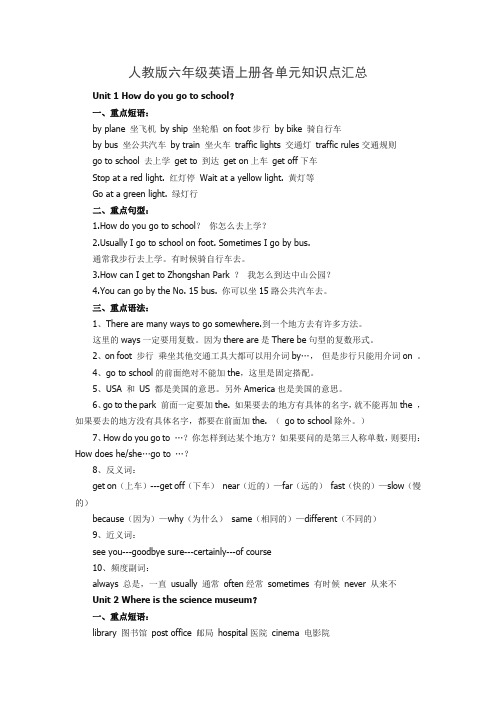
人教版六年级英语上册各单元知识点汇总Unit 1 How do you go to school?一、重点短语:by plane 坐飞机by ship 坐轮船on foot步行by bike 骑自行车by bus 坐公共汽车by train 坐火车traffic lights 交通灯traffic rules交通规则go to school 去上学get to 到达get on上车get off下车Stop at a red light. 红灯停Wait at a yellow light. 黄灯等Go at a green light. 绿灯行二、重点句型:1.How do you go to school?你怎么去上学?ually I go to school on foot. Sometimes I go by bus.通常我步行去上学。
有时候骑自行车去。
3.How can I get to Zhongshan Park ?我怎么到达中山公园?4.You can go by the No. 15 bus. 你可以坐15路公共汽车去。
三、重点语法:1、There are many ways to go somewhere.到一个地方去有许多方法。
这里的ways一定要用复数。
因为there are是There be句型的复数形式。
2、on foot 步行乘坐其他交通工具大都可以用介词by…,但是步行只能用介词on 。
4、go to school的前面绝对不能加the,这里是固定搭配。
5、USA 和US 都是美国的意思。
另外America也是美国的意思。
6、go to the park 前面一定要加the. 如果要去的地方有具体的名字,就不能再加the ,如果要去的地方没有具体名字,都要在前面加the. (go to school除外。
)7、How do you go to …?你怎样到达某个地方?如果要问的是第三人称单数,则要用:How does he/she…go to …?8、反义词:get on(上车)---get off(下车)near(近的)—far(远的)fast(快的)—slow(慢的)because(因为)—why(为什么)same(相同的)—different(不同的)9、近义词:see you---goodbye sure---certainly---of course10、频度副词:always 总是,一直usually 通常often经常sometimes 有时候never 从来不Unit 2 Where is the science museum?一、重点短语:library 图书馆post office 邮局hospital医院cinema 电影院bookstore书店science museum科学博物馆turn left向左转turn right 向右转go straight 直行north北south南east东west西next to靠近、与……。
新人教版PEP小学英语六年级上册各单元知识点总结.doc

人教版 (PEP)小学英语六年级上册单元知识点Unit 1 How can I get there ?一、主要单词:museum 博物馆bookstore 书店cinema 电影院turn 转弯left 向左right 向右straight 笔hospital 医院post office 邮局science科学直地crossing十字路口二、习惯语搭配:post office 邮局science museum科学博物馆pet hospital 宠物医院Italian restaurant 意大利餐馆Beihai Park北海公园Palace Museum 故宫博物院go straight 直走turn right/left 右 / 左转next to 挨着in front of...在...前面near the park 在公园附近on Dongfang Street 在东方大街上三、惯用表达式:Excuse me 打扰一下Follow me, please!请跟着我!四、公式化句型:1、问路的句型及其答语:问句: Where is the + 地点?···在哪儿?答: It's + 表示地点的。
它···。
next to the bookstore, near the hospital/post office,overthere,on Dongfang Street, in front of the school...2、怎么到某地的句型及其答:1 / 17句: How can +主+ get (to)+地点?···怎么到···?同句型:Can you tell me the way to +地点?Where is + 地点?Which isthe way to +地点?答: Turn +方向 +表示地点的介短。
人教版六年级下册英语知识点汇总

人教版六年级下册英语知识点汇总一、词汇1. 日常生活与社交•情感与态度词汇:happy, sad, angry, excited, surprised, worried 等。
•社交用语:invite, accept, refuse, apologize, congratulate, thank 等及其相关表达。
•节日与活动:Spring Festival, Mid-Autumn Festival, Christmas, birthday party, sports meeting 等。
2. 学校与学习•学习方法与策略:review, preview, note-taking, brainstorming 等。
•学科相关词汇:geography, history, biology, physics, chemistry(基础词汇)及学科活动。
3. 科技与未来•科技产品:computer, smartphone, internet, robot, AI 等。
•未来设想:space travel, environmental protection, renewable energy 等。
4. 旅行与交通•交通工具:plane, train, bus, subway, ship, bicycle 等。
•旅游景点与活动:museum, zoo, park, beach, hiking, camping 等。
二、语法1. 时态•熟练掌握一般现在时、一般过去时、现在进行时、一般将来时,并初步了解过去进行时和现在完成时的用法。
2. 语态•学习并理解被动语态的基本结构和用法。
3. 非谓语动词•初步接触动词不定式(to do)、动名词(doing)和分词(现在分词doing 和过去分词done)作为非谓语动词的用法。
4. 复合句•学习并列句和主从复合句(如宾语从句、状语从句、定语从句)的基本结构和用法。
三、句型与表达•能够根据语境运用多种句型进行表达,包括疑问句、祈使句、感叹句等。
英语六年级知识点人教

六年级英语教材知识点人教版六年级英语教材是以学习形式为主,内容贴近学生的生活实际,注重培养学生听、说、读、写等基本语言技能。
下面是人教版六年级英语教材的重要知识点。
一、语法知识:1.动词时态:现在时、过去时、将来时现在时:主语+动词原形(主语为第三人称单数时,动词要加-s或-es)过去时:主语+动词过去式将来时:主语+will+动词原形2.名词的单数和复数形式单数名词加-s或-es变为复数名词,有些名词变化不规则。
3.形容词的比较级和最高级比较级:形容词比较级+than最高级:the+形容词最高级+of4.人称代词的用法主格:I, you, he, she, it, we, you, they宾格:me, you, him, her, it, us, you, them5.反意疑问句的构成肯定主句+否定疑问句;否定主句+肯定疑问句二、词汇知识:1.数字及数词的表达0-zero, 1-one, 2-two, 3-three, 4-four, 5-five, 6-six, 7-seven, 8-eight, 9-nine, 10-ten, 11-eleven, 12-twelve, 13-thirteen, 14-fourteen, 15-fifteen, 16-sixteen, 17-seventeen, 18-eighteen, 19-nineteen, 20-twenty, 30-thirty, 40-forty, 50-fifty, 60-sixty, 70-seventy, 80-eighty, 90-ninety, 100-hundred2.与学习生活相关的词汇classroom, teacher, student, blackboard, chalk, book, ruler, eraser, pencil, pen, notebook, bag, desk, chair, school, library, canteen, playground, basketball, football, tennis, swimming, badminton3.时间、日期、星期4.家庭成员的称呼father, mother, parents, brother, sister, grandparents, grandpa, grandma, uncle, aunt, cousin三、句型知识:1.询问和回答姓名、年龄What's your name? My name is...How old are you? I am...years old.2.询问和回答日常活动What do you do on weekends? I usually...What did you do last weekend? I...What will you do next weekend? I...3.询问和回答喜好和能力What do you like? I like...What can you do? I can...四、短语和交际用语:1.问路用语Excuse me, can you tell me the way to...?2.询问时间和日期用语What's the date today?3.喜好和能力用语I like.../I can...I don't like.../I can't...What's your hobby? My hobby is...五、文化背景:1.英国文化:英国人的早餐、英国的交通工具、英国人的礼貌用语2.中国文化:中国节日、中国风俗习惯以上是人教版六年级英语教材的一些重要知识点,通过学习这些知识点,学生可以掌握基本的语法知识和词汇量,提高听、说、读、写的能力。
(完整版)小学六年级人教版英语总复习及知识点
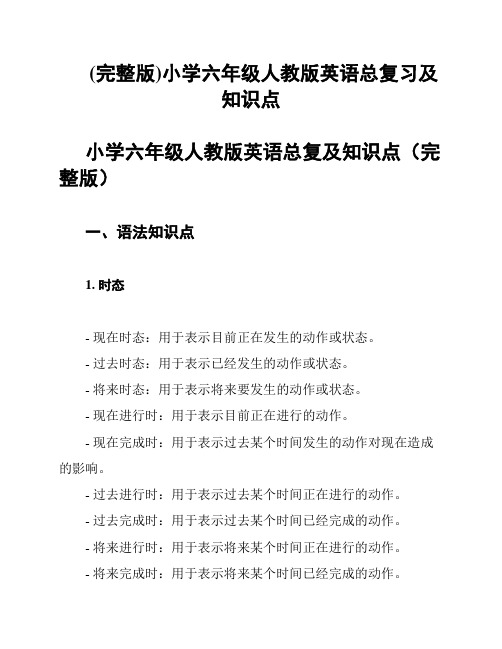
(完整版)小学六年级人教版英语总复习及知识点小学六年级人教版英语总复及知识点(完整版)一、语法知识点1. 时态- 现在时态:用于表示目前正在发生的动作或状态。
- 过去时态:用于表示已经发生的动作或状态。
- 将来时态:用于表示将来要发生的动作或状态。
- 现在进行时:用于表示目前正在进行的动作。
- 现在完成时:用于表示过去某个时间发生的动作对现在造成的影响。
- 过去进行时:用于表示过去某个时间正在进行的动作。
- 过去完成时:用于表示过去某个时间已经完成的动作。
- 将来进行时:用于表示将来某个时间正在进行的动作。
- 将来完成时:用于表示将来某个时间已经完成的动作。
2. 语法结构- 名词:用于表示人、动物、物体、地点等。
- 动词:用于表示动作或状态。
- 形容词:用于描述名词的特征或状态。
- 副词:用于修饰动词、形容词或其他副词。
- 介词:用于表示位置、时间或关系等。
- 代词:用于替代名词。
- 数词:用于表示数量。
- 冠词:用于限定名词的范围。
- 连词:用于连接词语、短语或句子。
3. 句子结构- 主语:句子中执行动作或承受动作的人或事物。
- 谓语:句子中说明主语动作或状态的部分。
- 宾语:句子中接受动作的人或事物。
- 定语:用于修饰名词或代词的成分。
- 状语:用于修饰动词、形容词、副词或整个句子的成分。
- 表语:用于说明主语的状态或特征的部分。
二、总复内容1. 单词- 请根据教材中的单词表,复并牢记相关的单词拼写和意思。
2. 句子- 复教材中的对话和句子,理解并掌握其基本意思和用法。
3. 对话- 复教材中的对话,掌握其中的日常生活用语和表达方式。
4. 语法- 复教材中的语法知识点,加深对时态、语法结构和句子成分的理解。
三、研究方法1. 多听多说- 多听英语教材、歌曲或英语广播,提高听力水平。
- 多说英语,练口语表达和语音准确性。
2. 多读多写- 多读英语教材、故事书等,提高阅读理解能力。
- 多写英语作文,锻炼自己的写作能力和语法运用。
人教版六年级上册英语知识点汇总
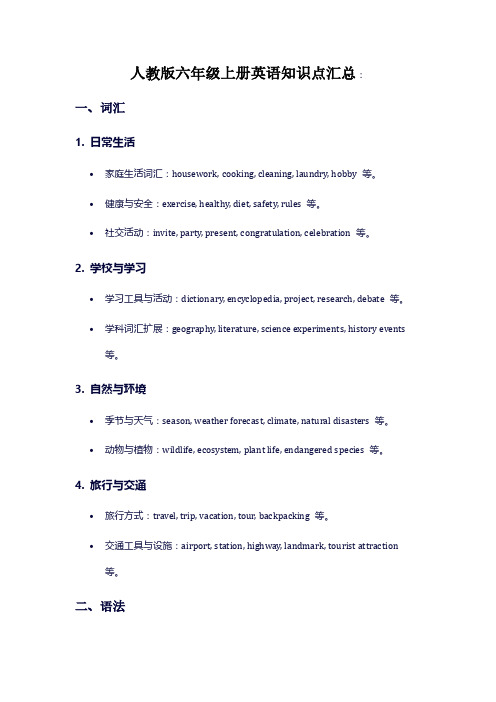
人教版六年级上册英语知识点汇总:一、词汇1. 日常生活•家庭生活词汇:housework, cooking, cleaning, laundry, hobby 等。
•健康与安全:exercise, healthy, diet, safety, rules 等。
•社交活动:invite, party, present, congratulation, celebration 等。
2. 学校与学习•学习工具与活动:dictionary, encyclopedia, project, research, debate 等。
•学科词汇扩展:geography, literature, science experiments, history events 等。
3. 自然与环境•季节与天气:season, weather forecast, climate, natural disasters 等。
•动物与植物:wildlife, ecosystem, plant life, endangered species 等。
4. 旅行与交通•旅行方式:travel, trip, vacation, tour, backpacking 等。
•交通工具与设施:airport, station, highway, landmark, tourist attraction 等。
二、语法1. 时态•深入巩固一般现在时、一般过去时和一般将来时。
•初步学习过去进行时,理解其在描述过去某个时间点正在进行的动作或状态中的作用。
2. 句型结构•学习并列句和复合句,特别是条件状语从句、时间状语从句和原因状语从句的用法。
•掌握和使用形容词和副词的比较级和最高级形式来描述和比较事物。
3. 语态•进一步理解主动语态和被动语态的区别,并能在适当语境中运用。
三、听力与口语•能够听懂日常对话、短文、新闻广播等,理解主要信息和细节。
•能够就熟悉的话题进行流畅的口头表达,包括描述、讨论、提问和回答。
六年级英语人教版知识点
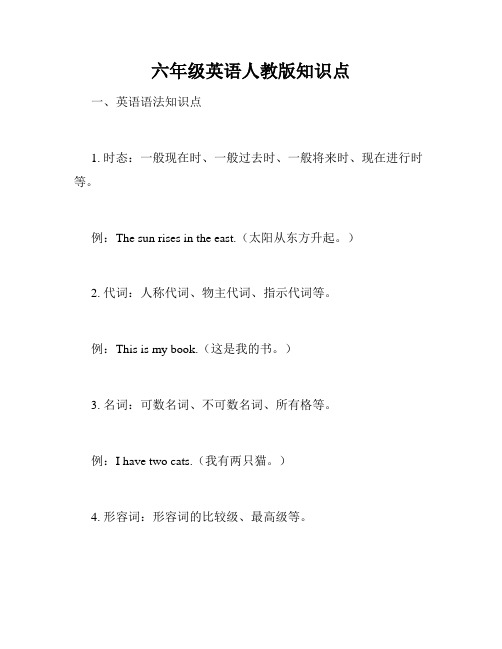
六年级英语人教版知识点一、英语语法知识点1. 时态:一般现在时、一般过去时、一般将来时、现在进行时等。
例:The sun rises in the east.(太阳从东方升起。
)2. 代词:人称代词、物主代词、指示代词等。
例:This is my book.(这是我的书。
)3. 名词:可数名词、不可数名词、所有格等。
例:I have two cats.(我有两只猫。
)4. 形容词:形容词的比较级、最高级等。
例:The blue whale is the largest animal on Earth.(蓝鲸是地球上最大的动物。
)5. 副词:表示时间、地点、方式等的副词。
例:She dances beautifully.(她跳舞跳得很漂亮。
)二、英语词汇知识点1. 词汇扩展:动词、形容词、副词的词义扩展。
例:happy → happiness(快乐→ 幸福)2. 同义词和反义词:学习掌握常见的同义词和反义词。
例:big → large(大→ 大)3. 常用词组:学习掌握常用的英语词组。
例:take care of(照顾)4. 熟练运用:学习根据语境熟练运用各类词汇。
例:I like to eat apples.(我喜欢吃苹果。
)三、英语听力和口语知识点1. 听力训练:通过听故事、对话等培养对英语听力的理解能力。
2. 口语练习:多进行口语交流,提高口语表达能力。
3. 问题解答:学会用英语回答常见问题。
例:Q: What's your favorite color?(你最喜欢的颜色是什么?) A: My favorite color is blue.(我最喜欢的颜色是蓝色。
)四、英语阅读和写作知识点1. 阅读文章:掌握课堂上学习的阅读技巧,提高阅读理解能力。
2. 写作练习:进行英语作文写作练习,提高写作能力。
3. 文章结构:学会组织文章结构,使文章内容条理清晰。
例:My Summer Vacation(我的暑假)This summer vacation, I went to my grandparents' house.(今年暑假,我去了我祖父母的家。
人教版六年级英语上册知识点重点难点考点汇总

六年级英语上册知识点重点难点考点汇总第一单元:How can I get there?1. 重点知识点-词汇:掌握表示地点的词汇,如museum(博物馆)、post office(邮局)、bookstore(书店)、cinema(电影院)、hospital(医院)、crossing(十字路口)、turn(转弯)、left(左边)、right(右边)、straight(笔直地)等,以及问路和指路相关的短语,如excuse me(打扰一下)、near(在……附近)、next to(在……旁边)、in front of(在……前面)。
-句型:能用“How can I get to...?”询问如何到达某地,并回答“Turn left/right at...”或“Go straight...”等。
例如:“How can I get to the bookstore?”“Turn left at the second crossing.”能用“Is there a... near here?”询问附近是否有某地,并回答“Yes, there is. / No, there isn't.”-发音:学习字母组合ou 在单词中的发音,如sound(发音为[au],意为“声音;听起来好像”),count(发音为[au],意为“数数”);字母组合ow 在单词中的发音,如down(发音为[au],意为“向下”),window(发音为[əʊ],意为“窗户”)。
2. 难点-准确记忆和区分各种表示地点的词汇,以及在问路和指路句型中正确使用方位介词和短语。
-对于一些复杂的问路情境,能够准确地描述路线,包括转弯、经过的地点等信息。
3. 考点-地点词汇和问路指路短语的拼写与理解,如根据中文写英文、选择正确单词描述地点。
-句型的运用,包括根据情景补全问路和指路的对话、问答。
-字母组合ou 和ow 发音的判断,如判断单词中字母组合发音是[au]还是[əʊ]。
人教版六年级上册英语知识点
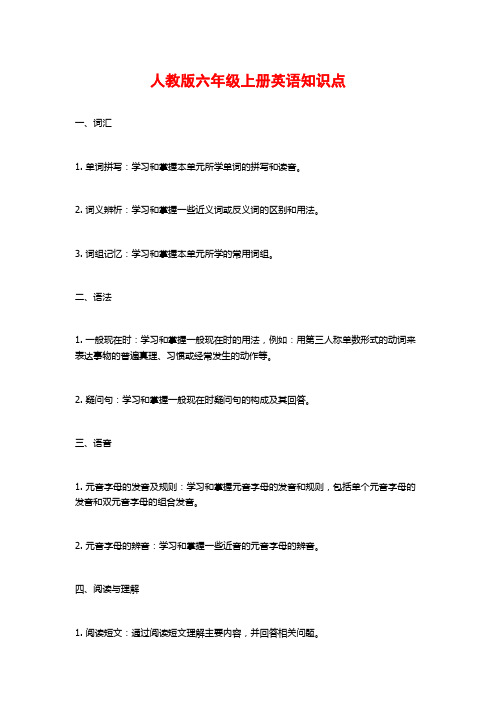
人教版六年级上册英语知识点
一、词汇
1. 单词拼写:学习和掌握本单元所学单词的拼写和读音。
2. 词义辨析:学习和掌握一些近义词或反义词的区别和用法。
3. 词组记忆:学习和掌握本单元所学的常用词组。
二、语法
1. 一般现在时:学习和掌握一般现在时的用法,例如:用第三人称单数形式的动词来表达事物的普遍真理、习惯或经常发生的动作等。
2. 疑问句:学习和掌握一般现在时疑问句的构成及其回答。
三、语音
1. 元音字母的发音及规则:学习和掌握元音字母的发音和规则,包括单个元音字母的发音和双元音字母的组合发音。
2. 元音字母的辨音:学习和掌握一些近音的元音字母的辨音。
四、阅读与理解
1. 阅读短文:通过阅读短文理解主要内容,并回答相关问题。
2. 根据上下文猜词义:通过上下文理解词义,并应用到具体的语境中。
五、写作
1. 填写单词:根据图片和提示填写单词,培养学生的观察力和动手能力。
2. 仿写句子:根据模板和相关词汇,进行句子仿写,培养学生的语言运用能力。
以上是人教版六年级上册英语的主要知识点概述,具体的知识点还需根据教材内容进行细化学习。
人教版六年级上册英语重点知识点归纳
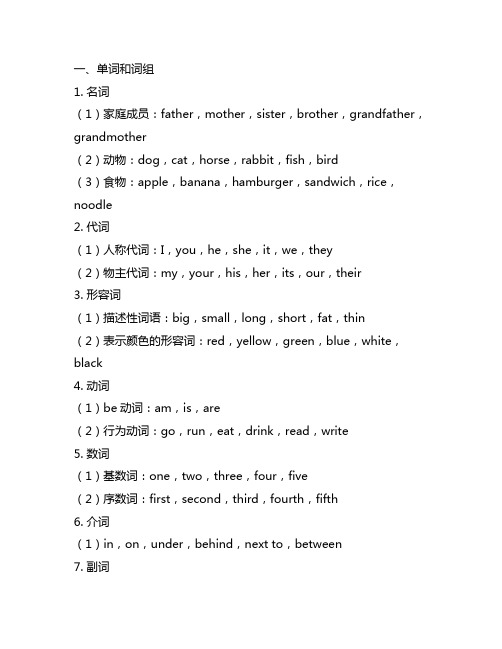
一、单词和词组1. 名词(1)家庭成员:father,mother,sister,brother,grandfather,grandmother(2)动物:dog,cat,horse,rabbit,fish,bird(3)食物:apple,banana,hamburger,sandwich,rice,noodle2. 代词(1)人称代词:I,you,he,she,it,we,they(2)物主代词:my,your,his,her,its,our,their3. 形容词(1)描述性词语:big,small,long,short,fat,thin(2)表示颜色的形容词:red,yellow,green,blue,white,black4. 动词(1)be动词:am,is,are(2)行为动词:go,run,eat,drink,read,write5. 数词(1)基数词:one,two,three,four,five(2)序数词:first,second,third,fourth,fifth6. 介词(1)in,on,under,behind,next to,between7. 副词(1)频度副词:always,usually,sometimes,never (2)程度副词:very,quite,too8. 连词(1)and,but,because9. 情态动词(1)can,could,may,might二、语法1. 一般现在时(1)肯定句形式:主语+动词原形+其他(2)否定句形式:主语+be动词+not+动词原形+其他(3)疑问句形式:Be动词+主语+动词原形+其他?2. 物主代词(1)第一人称单数:my(2)第二人称单数:your(3)第三人称单数:his,her,its(4)第一人称复数:our(5)第二人称复数:your(6)第三人称复数:their3. be动词(1)肯定句形式:主语+be动词+其他(2)否定句形式:主语+be动词+not+其他(3)疑问句形式:Be动词+主语+其他?4. 数词(1)基数词用法:表示数量,如one,two,three (2)序数词用法:表示顺序,如first,second,third 5. 介词短语(1)in/on/under+名词:表示位置(2)behind/next to/between+名词:表示位置关系三、对话1. 问候与介绍(1)Hello,I’m…(2)What’s your name?(3)How are you?2. 家庭成员介绍(1)This is my father/mother/sister/brother. (2)Is she your mother?(3)Yes, she is.3. 动物和食物(1)Do you have a pet?(2)Yes, I have a cat/dog/…(3)What’s your f avorite food?(4)My favorite food is…四、阅读1. 短文阅读Mary is a girl. She has a big family. She has a father, a mother, a sister and a brother. They have a dog and a cat. Mary’s favorite food is hamburger. She likes playing with her pets.2. 阅读理解(1)根据短文内容判断正误。
人教版小学六年级英语上册知识点总结和复习要点
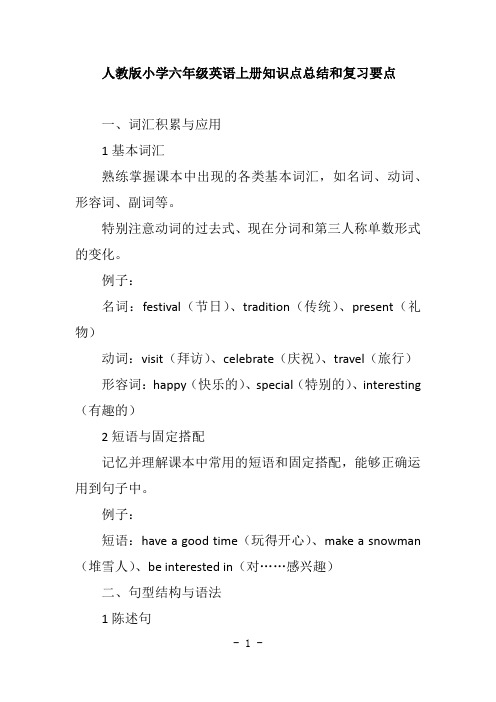
人教版小学六年级英语上册知识点总结和复习要点一、词汇积累与应用1基本词汇熟练掌握课本中出现的各类基本词汇,如名词、动词、形容词、副词等。
特别注意动词的过去式、现在分词和第三人称单数形式的变化。
例子:名词:festival(节日)、tradition(传统)、present(礼物)动词:visit(拜访)、celebrate(庆祝)、travel(旅行)形容词:happy(快乐的)、special(特别的)、interesting (有趣的)2短语与固定搭配记忆并理解课本中常用的短语和固定搭配,能够正确运用到句子中。
例子:短语:have a good time(玩得开心)、make a snowman (堆雪人)、be interested in(对……感兴趣)二、句型结构与语法1陈述句复习并巩固陈述句的基本结构,能够正确构建和表达完整的句子。
例子:陈述句:I like playing football in the afternoon.(我喜欢下午踢足球。
)2疑问句学习和掌握特殊疑问句、一般疑问句及其回答方式,能够准确理解并回答问题。
例子:特殊疑问句:What do you usually do on your birthday?(你生日通常做什么?)回答:I usually have a birthday party with my friends.(我通常和朋友们一起举办生日派对。
)3祈使句巩固祈使句的基本用法,能够正确使用祈使句表达请求、命令或建议。
例子:祈使句:Please don’t forget to bring your homework tomorrow.(请别忘了明天带作业来。
)4时态复习并巩固一般现在时、一般过去时、一般将来时和现在进行时等时态的基本用法和形式。
例子:一般现在时:She often reads books after dinner.(她晚饭后经常看书。
)一般过去时:We went to the zoo last weekend and saw many animals.(我们上周末去了动物园,看到了很多动物。
新人教版六年级英语知识点

新人教版六年级英语知识点New Curriculum of Primary School – Grade 6 English Knowledge PointsAs per your request, this article will focus on the English knowledge points covered in the new edition of the sixth grade textbooks. The article will be structured as follows:1. Introduction to the New Curriculum2. Listening Skills3. Speaking Skills4. Reading Skills5. Writing Skills6. Grammar7. Vocabulary8. ConclusionIntroduction to the New CurriculumThe new curriculum for sixth grade English, based on the New Curriculum Standards, is designed to enhance students' language proficiency and communication skills. It aims to provide a solid foundation for further studies in English. The curriculum includes various knowledge points to cultivate listening, speaking, reading, and writing abilities.Listening SkillsIn this section, students will develop their listening skills through a range of activities. They will practice understanding English spoken at a normal pace, picking up on the main points, and comprehending dialogue. Additionally, they will learn to identify specific information such as time, location, and people involved.Speaking SkillsSpeaking skills are developed through interactive activities that encourage students to express themselves confidently. They will engage in conversations, role-plays, and group discussions to improve their ability to communicate in English. Emphasis is also placed on pronunciation and intonation, enabling students to express themselves accurately.Reading SkillsStudents will enhance their reading skills by exploring a variety of reading materials. This includes fiction and non-fiction texts, news articles, and poems. They will learn strategies such as skimming, scanning, and inferring meaning from context. Comprehension questions will test their understanding of the texts and their ability to make connections.Writing SkillsThe writing component focuses on developing students' ability to express themselves effectively in written form. They will learn various genres, such as narratives, descriptive writing, and persuasive essays. Through guided practice, they will improve their sentence structure, grammar, and vocabulary usage. Students will also be encouraged to proofread and edit their work for clarity and coherence.GrammarGrammar forms a fundamental part of language learning. The sixth-grade curriculum introduces and reinforces various grammar structures, including tenses, subject-verb agreement, question formation, and prepositions. These grammatical elements are integrated into exercises and activities, allowing students to practice and apply what they have learned.VocabularyThe vocabulary component enhances students' word knowledge, enabling them to expand their range of expression. Students will learn new words through context, word families, and collocations. Importance is placed on learning words in meaningful contexts to better understand their nuances and usage.ConclusionThe new curriculum for grade 6 English offers a comprehensive approach to language learning, covering listening, speaking, reading, writing, grammar, and vocabulary. By emphasizing practical communication skills, it equips students with the necessary tools to confidently use English in real-life situations. With the completion ofthis curriculum, students will be well-prepared for further English language studies and communication in the future.。
- 1、下载文档前请自行甄别文档内容的完整性,平台不提供额外的编辑、内容补充、找答案等附加服务。
- 2、"仅部分预览"的文档,不可在线预览部分如存在完整性等问题,可反馈申请退款(可完整预览的文档不适用该条件!)。
- 3、如文档侵犯您的权益,请联系客服反馈,我们会尽快为您处理(人工客服工作时间:9:00-18:30)。
新人教版六年级英语知识点总结随着小学英语教学日益为国家和全社会所重视,在许多地方的小学英语已经成为了一门必修课。
新人教版六年级英语有哪些知识点呢?接下来我为你整理了,一起来看看吧。
新人教版六年级英语知识点:句型1. allow sb to do sth 允许某人去做某事(后接动词不定式)My father allowed me to go out for a walk after finishing my homework.2. asked sb (not) to do sth 叫某人做事某事(叫某人不要去做某事) My father asked me to study hard.He asked me not to swim alone.be asked to do sth 被叫去做某事/被邀请去做某事I was asked to have a dinner with them yesterday.3. be afraid to do sth 害怕做某事She is afraid to ask me questions.4. be afaid of doing sth 害怕做某事I am afraid of going out at night.5. be afaid of sth 害怕某物He is afraid of snakes.6. be amazed to do sth 对做某事感到惊讶He was amazed to meet the girl there.be amazed at sth 对某事感到惊讶they were amazed at the news.7. be busy doing/with sth 忙于做某事(常考)I was busy washing my car at that time. 那时候我正忙于清洗我的车子。
I am busy with my work.8. be coming/going/leaving/fiying/moving/dying(某些位移动词用进行时态时表将来)the bus is coming/the dog is dying.9. be excited to do sth 对做......感到兴奋Jacky was excited to travel there by plane.be excited at sthLily was excited at his words.be excited about doing sthhe was excited about passing the exam without going overing books.10. be frightened to do sth 害怕去做某事Sam is frightened to ride a horse.11. be glad/happy to do sth 高兴去做某事She is happy to clean theblackboard with me.be pleased to do sth高兴做某事She was pleased to helpthe old man yesterday.be pleased with sth 对某事感到高兴/满意The teacher was pleasedwith my answer.12.be interested in sth/doing sth 对某事感兴趣/对做某事感兴趣 She is interested inswimming in the river.My btother is interestedin Chinese.13. be/get ready for/to do sth be ready for 为某事做好了准备 We are ready for the exam.Be ready to do sth 为做某事做好了准备We are ready to have a birthday party for her.get ready for sth为某事在做准备We are getting ready for the exam.14. be surprised to do sth 对做某事感到惊奇be surprised at sth 对某事感到惊奇This is nothing to be surprised at.Id be surprised to see him on such an occasion.15. be worth doing sth 值得做某事(worth 后接动词-ing形式,常考) It was too remote to be worth thinking about.16. begin to do sth begin/start to do/doing sth开始去做某事When do children begin to go to school?17. can/be able to afford (to buy) sth 有能力负担(购买)...... At this rate we wont be able to afford a holiday.18. can/may/must do sth 能/可以/必须做某事could/would/should/might do sth 能/将/应该/可以做某事We may come at another time.19. cant wait todo sth 迫不急待地去做某事I cant wait to hear the news.20. decide to do sth 决定去做某事make up ones mind to do sth 下决心去做某事(常考)make a decision to do sth 对做某事作出决定What do they decide to do?I have made up my mind to go with him新人教版六年级英语知识点:be动词的用法口诀be 的用法口诀我用am,你用are,is连着他,她,它;单数名词用is,复数名词全用are。
变疑问,往前提,句末问号莫丢弃。
变否定,更容易,be后not莫忘记。
疑问否定任你变,句首大写莫迟疑。
be动词的用法:be (be/is/are/am/was/were)现在时 I am, you are, he is, we are, you are, they are (缩略式Im, youre, hes, were, youre, theyre), (否定缩略式 Im not, isnt, arent), 过去时 I was, you were, he was, we were, you were, they were (过去时否定缩略式 wasnt, werent), 过去分词been, 现在分词being英语的"be"是个特殊动词;有些语言,如马来文等,并没有"be"这样的动词。
"Be"除了原形的"be"之外,还有另外七种形式:am, is, are, been, being, was, were.在句子中,"be"可以是主动词(The Principal Verb)或助动词(The Auxiliary Verb)例句对照【当主动词时,"be"在性质上属于接系动词(The Linking Verb), 后面要有名词、形容词、地方副词或短语作补足语(The Complement)。
例如: 1. The man is a science teacher.这个男子是一位科学教师2. Marys new dresses are colourful.玛丽的新衣服色彩鲜艳3. I have been there before.我以前去过那里4. My mother is watching TV in the room.母亲现在在客厅看电视【这四个都是陈述句,可以变成疑问句,方法简单,把主语和"be"或助动词对换位置即可:5. Is the man a science teacher?6. Are Marys new dresses colourful?7. Have I been there before?8. Is mother in the kitchen now?【当"be"要在祈使句中出现时,它必须借重助动词"do"或"dont"之助,如:9. Dont be silly!10. Do be obedient!11. Dont be a fool!【"Be"有两种缩写法,如下:12. Hes not...../He isnt....13. Youre not...../You arent...【但"am + not"的缩写法只有一个:14. Im not.有人用"aint", 但这并不是标准英语。
谈过了"be"作主动词的功能,现在看看"be"作助动词时,有些什么用法:【1.】"Be + 现在分词"以组成进行式时态(Continuous Tenses),如:15. Tonys maid is washing his new car.16. The children are playing in the field.17. Samuel was eating when I came in.18. We have been living here since 1959.【2.】"情态动词+Be + 过去分词"以组成被动语态(The Passive Voice),如:19. Her money in the drawer was stolen.20. A number of good jobs are taken up byforeigners.21. David studied in Taiwan but has been trained as a language lecturer in America.22. Can all the wonderful birds be found in our Bird Park?23. The disobedient boy was told to stand out- side the classroom.24. Steps are being taken to reduce traffic con- gestion during peak hours.25. Dishonest students will be immediately dealt with.新人教版六年级英语知识点:定语从句中关系代词六个关系代词是:that/which/ who/ whom/ whose/ as ,注意关系代词在定语从句中做主宾表定语。
